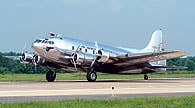
The Smithsonian National Air & Space Museum welcomed the Boeing S-307 Stratoliner to its new home, the Steven F. Udvar-Hazy Center. Originally built in the late 1930s, the four-engine Stratoliner was the world's first pressurized passenger airplane, allowing it to fly at altitudes of 20,000 feet, which was unprecedented for that era.
The sole survivor out of less than a dozen Stratoliners, the Clipper Flying Cloud led a rather glamorous life. Starting out as one of Pan American's fleet in 1940, the aircraft ultimately had 45 passenger seats. During World War II, the Clipper Flying Cloud was flown in South America under the direction of the U.S. Army Air Forces. The Stratoliner later fell into the hands of a notorious Haitian leader, "Papa Doc" Duvalier, who used it as an executive transport.
Eventually, the airplane wound up at a boneyard in Arizona, where, in 1969, a curator from the Smithsonian recognized it and immediately acquired the airplane for the museum, saving it from being converted into a fire bomber. In the late 1990s, the airplane was brought to Seattle, where volunteers at Boeing, along with former Pan Am employees, spent six years rebuilding and restoring the Stratoliner back to its original glory.

Sign-up for newsletters & special offers!
Get the latest FLYING stories & special offers delivered directly to your inbox






